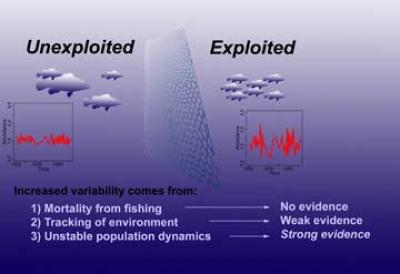Fishing activities can provoke volatile fluctuations in the populations they target, namely by altering the “age pyramid.” Lopping off the few large, older fish that make up the top of the pyramid leaves a broad base of faster-growing small younglings and the research team found that this rapidly growing and transitory base is dynamically unstable — a finding having profound implications for the ecosystem and the fishing industries built upon it.
Imagine a container of water with a 500-pound fish. With food, it grows a little bigger. Without food it gets a bit smaller. Imagine the same container with 500 one-pound fish. They eat, reproduce and the resulting thousands of fish boom, quickly outstripping the resources and the population crashes. These many smaller fish — with the same initial “biomass” as the larger fish — can’t average out the environmental fluctuations, and in fact amplify them through higher turnover rates that promote boom and bust cycles.

Fishing typically extracts the older, larger members of a targeted species and fishing regulations often impose minimum size limits to protect the smaller, younger fishes.
“That type of regulation, which we see in many sport fisheries, is exactly wrong,” said Professor George Sugihara of Scripps Institution of Oceanography. “It’s not the young ones that should be thrown back, but the larger, older fish that should be spared. Not only do the older fish provide stability and capacitance to the population, they provide more and better quality offspring.”
Thus the danger, according to Sugihara, is that current policies that manage according to current biomass targets (without significant forecast skill) while ignoring fish size pose risks that can further destabilize the population. This instability can in principle propagate systemically to the whole ecosystem, much like a stock market crash or a domino effect, and magnify risk for the fishing industry itself as well as those of ecologically related fisheries.
This is especially true when trying to rebuild fish stocks, Sugihara says.
“This may be the most important implication of this work, as we attempt to rehabilitate fisheries,” said Sugihara. “Regulations based solely on biomass harvest targets are incomplete. They must also account for age-size structure in the populations,” he said. “Current policies and industry pressures that encourage lifting bans on fishing when biomass is rehabilitated—but where maximum age and size are not—contain risk.”
This is currently the case with Atlantic swordfish, for which industry pressures to resume fishing are based on the restoration of historic biomass levels, even though the swordfish are clearly undersized.
“In the extreme case, the danger of such unstable dynamics for certain populations for management is that harvest targets may lag the population, potentially making things worse,” said Sugihara. “A high harvest target may be set after an especially abundant period when the population may be poised to decline on it’s own. Likewise future abundant periods may represent missed opportunities, despite current low abundances. As senior officials of the Canadian Department of Fisheries and Oceans have said, ‘we are often a year behind in our stock projections.’”
Sugihara cautioned that nonlinearity is not unique to fished species. Nonequilibrium overshooting and undershooting occurs in unexploited stocks, but to a lower extent. Therefore, classical single-species population models that require equilibrium are unlikely to be very successful in stock forecasts, except perhaps in the very short term.
"Other methods that do not rely on these assumptions may be more promising," suggests Christian Anderson, paper co-author.
In addition to Sugihara and Anderson, the study included Scripps Oceanography alumnus Chih-hao Hsieh (now a professor at National Taiwan University); Stuart Sandin of Scripps; Roger Hewitt of the National Marine Fisheries Service, Southwest Fisheries Science Center; Anne Hollowed of the National Marine Fisheries Service, Alaska Fisheries Science Center; Sir John Beddington of Imperial College London (current Chief Science Advisor to the United Kingdom) and Lord Robert May of Oxford (a former Chief Scientific Advisor to the UK).
The research was supported by NOAA Fisheries and the Environment program, The MacQuown Chair of Natural History, The Deutsche Bank – Jameson Complexity Studies Fund, the Sugihara Family Trust and the Kyoto University grant for Biodiversity Research of the 21st Century.






Comments